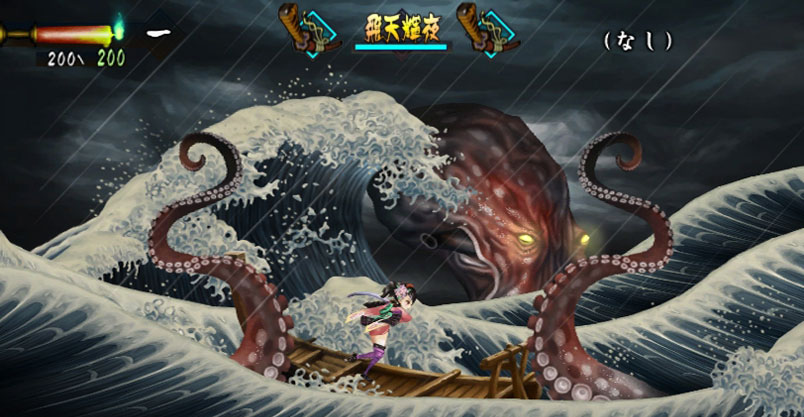I love seeing great games on the Wii. Muramasa: The Demon Blade most certainly falls into that category. It is one of the best entries into the evanescent beat-em-up (slash-em-up?) genre in recent memory, and is Vanillaware’s best effort to date… and that’s saying a lot.
On top of the unparalleled sprite-based, hand-drawn, multi-layered, parallax-scrolling graphics that lovingly caress players’ retinas from the second they load up the game, and enveloped within a thematically-appropriate, flute-and-lute-rich, traditional Japanese soundscape, players will find that Muramasa delivers steadily enjoyable gameplay from start to finish, with only a slight tarnish from repetition.

Muramasa plays just like it should. That is to say that a game about samurais, ninjas, monsters, and demon blades in a fictional 17th-century Japan should be smooth, responsive, and manageable, putting the player firmly in control of his or her character’s actions and letting them feel the power of slicing through enemies by stringing together combinations of various types of attacks with relative ease and simplicity. Muramasa, blending and simplifying the guiltily satisfying swordplay of Ninja Gaiden, the layered level presentation and progression of the Metroid franchise, and the crafting, leveling, and inventory elements of most JRPGs, does that, and more.
Each time they load the game, players may take control of Kisuke, an amnesiac ninja, or Monohime, a possessed princess, and continue either of two separate but interweaving storylines. These follow different paths through the well-mapped provincial Japan, through different locales and with different enemies, making each character’s story a distinct gameplay experience. Three difficulty modes are available, ranging from the forgiving Muso setting to the deadly Shigurui mode (available only after completing the game once), which limits the player’s hit points to 1. Shuro is the initial “hard” difficulty setting, and requires better combat precision than Muso mode. There are also multiple endings, giving players more reason to replay Muramasa.
No matter the difficulty setting, which can be changed mid-game, play consists of advancing through multi-sectional levels with the aim of reaching a particular location, where a boss character waits and a few short cutscenes further flesh out the plot. On the way to these milestone confrontations, groups of enemies will appear, sometimes detaining the player until all are vanquished, and sometimes permitting them to continue without bloodshed. The bosses are all large and finely detailed, of unique and fantastical design, and each requires a different attack strategy to defeat. Doing so will clear that province of enemies and grant players a special blade and the ability to break down one of many colored barriers blocking the way at key locations on the map, thus allowing further progress, and setting the stage for their next goal.
Combat itself is like walking on air, and although the fights with ninjas, samurai, gremlins, griffins, kappa, giant frogs, etc. occur on a frequent basis, they rarely feel like a disturbance or an imposition on the player’s gameplay experience. Using the simple control scheme, players can string together flurries of attacks from the very start without breaking a sweat. A possible downside of this is that there’s nothing new to learn throughout the game, but I’m not entirely convinced that the sequential discovery of techniques makes for a better experience than the perfection of a well-rounded initial moveset. In Muramasa, A is the primary attack button, and is very mashable for simple combos, but direction modifiers can be applied as well. While holding the A button, pressing up on the control stick makes Kisuke and Monohime perform a vertical slash, and pressing left or right sends them gliding across the screen, slashing anything in their path. The latter can be done up to three times in a row. While airborne, normal attacks keep the blade wielder suspended like a Hokusai-painted hummingbird of death, and pressing down + A delivers a swift downward thrust to anything below. The B button unleashes the currently equipped weapon’s Spirit Power, which is a more powerful attack, unique to each blade.
[flash width=”480″ height=”295″]http:/www.youtube.com/v/rKl0o3B4Sr4&hl=en&fs=1&rel=0&color1=0x3a3a3a&color2=0x999999[/flash]
Spirit Powers, along with regular use and blocking (hold down A), diminishes a sword’s Soul Power, which is like a hit points bar for folded steel. When the meter is depleted, the sword breaks, and another must be selected. Three demon blades are equipped at any given time, and each has its own attack power, special effect (stat boosts, resistances, etc.), and aforementioned Spirit Power. Players will constantly switch from one to the next as swords break and revitalize, and doing so at the right moments trigger screen-wide blade storms, much like the effects in arcade beat-em-ups and shooters. There is little diversity in the way the different swords handle — there are essentially two types: short, quick blades and long, powerful blades — but maintaining a good balance of size and effect can still be important, especially on the higher difficulty settings or during boss fights.
There is a sea of swords in Muramasa. Some are earned by defeating bosses, but most must be created in the game’s blade-forging tree. To make new, more powerful weapons, the ethereal swordsmith Muramasa requires souls, collected from the environment and fallen opponents, and spirit, drawn from food and recovery items. The availability of blades is limited by these factors, the blades in one’s possession, and Kisuke or Monohime’s strength and vitality, which increase as they gain levels from battle.
There is little more one can ask of a game like Muramasa. Aside from backtracking, which is slightly eased by the infrequent use of boats and palanquins to travel quickly across the map, there isn’t anything wrong with the game. The visuals, which should be self-evident, represent some of the best artistic design in all of videogames, and the perfectly matched music conjures images of traditional Japan, as well as another critical darling, Okami. Anyone who owns a Wii and enjoys videogames should play Muramasa.

















